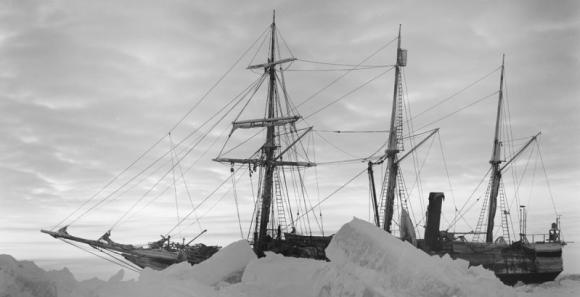 Next January and February, an expedition to Antarctica will search for Ernest Shackleton‘s doomed ship, Endurance, crushed by the ice in 1915. Finding the wreck of the ship is not the primary objective of the venture, however, which is to study the Larsen C ice shelf, where last summer one of the largest icebergs in recorded history calved from the ice shelf. The iceberg was almost the size of the state of Delaware and contained roughly a trillion tons of water.
Next January and February, an expedition to Antarctica will search for Ernest Shackleton‘s doomed ship, Endurance, crushed by the ice in 1915. Finding the wreck of the ship is not the primary objective of the venture, however, which is to study the Larsen C ice shelf, where last summer one of the largest icebergs in recorded history calved from the ice shelf. The iceberg was almost the size of the state of Delaware and contained roughly a trillion tons of water.
The Endurance is thought to have sunk in water 3,000 meters deep, beneath the Larsen C Ice Shelf in the Weddell Sea, relatively close to the location where the ice shelf research is scheduled to take place. In addition to their other activities, the team hopes to succeed where three previous attempts to find the stricken Endurance have failed.
The Endurance was part of the failed “Imperial Trans-Antarctic Expedition.” The ship became trapped in the Antarctic ice and was ultimately crushed and sank in November of 1915. The 28 survivors spent the next five months on Antarctica’s ice floes, eventually reaching Elephant Island. Expedition leader Ernest Shackleton, along with five others, sailed for help to South Georgia Island—located 920 miles away— in one of the Endurance‘s lifeboats. The entire crew was finally rescued in August 1916.
The upcoming expedition will be lead by the University of Cambridge’s Scott Polar Research Institute (SPRI) and will operate from the icebreaking polar-supply and research-vessel SA Agulhas II and will use advanced unmanned technology to survey the seabed.
Prof Julian Dowdeswell, the director of the SPRI told the BBC, “In our study of Larsen, we will be operating autonomous underwater vehicles (AUVs). But if we can get them in range of where Endurance is thought to be, we will send them under the ice to do a survey.
“They are fitted with downward-looking multi-beam echo-sounders, which can map out on a grid the shape of the seafloor. You look at that for any signs of the ship and then focus in with cameras if you find something interesting.”

I thought they both had been found already on the ocean floor, one of them had been stuck in a ice floe while the other did get into a sheltered bay. I dont remember the reasoning. Yet where Shackletons crew was headed after setting off on foot. One of his boats was found on the bottom near where Shackleton had intended to walk.